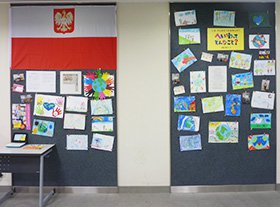Connected Also Online
Jagiellonian University
KURIHARA Sachiko
Eighteen months have passed since I took up my post as a Japanese-Language Specialist in Poland. In last year’s report, I wrote about the online classes that began suddenly as a result of the spread of COVID-19 around the world. I had no expectations of this at the time, but those online classes that we started in March 2020 are still continuing in May 2021.
Japanology is part of the Institute of Oriental Studies in Jagiellonian University’s Faculty of Philology; in September 2020, the Institute finally moved into its new building after renovation was complete. Before the start of the new semester in October, I also participated in an information session held in the new building and looked around the new shared research room. However, following this, although we began the new semester with some face-to-face classes and the rest online, we returned to online classes again for all lessons after around two weeks due to the spread of the virus. As a result, we have barely used the new building for any classes, even though time is passing.

The new building, which contains the Institute of Oriental Studies in the Faculty of Philology, Jagiellonian University
Notably, the first year students in the bachelor’s and master’s courses, who entered the University in October, have moved to online classes without really meeting their classmates. Therefore, we are providing opportunities for them to get to know each other (through pair and group activities, etc.), and focusing on activities that will create a good atmosphere in the Japanese-language classes—the students are also tackling this with enthusiasm. When I was carrying out an activity “to explain what we are wearing” with the first-year students, they all got creative and appeared on-screen with unique appearances, including a student who wore a wig and long, elegant gloves; a student who wore a tiara and horns; a student wearing a skeleton costume and a character costume; a student who wore a hat with flower embroidery; and a student who wore Frida Kahlo socks, even though we couldn’t see them on-screen at the start; thanks to these unique appearances, the class was filled with laughter. Plus, it was also a good chance for the students to use expressions and vocabulary that don’t come up in regular classes or in the textbooks used by the first year students.
Connecting with Japan
One of the merits of the online format is that it is easy to interact with people across distances. During the 2020–2021 academic year, we ran the student exchange “Onigiri Project” and the “Heiwa-tte Donna Koto? Project” (The “What is Peace? Project”) between Jagiellonian University and Shiga University. In the first half of each Onigiri Project exchange meeting, the students participated in lectures by a Kyo-Yuzen (special dyeing technique of kimono) artist, the president of a futon company, the teachers of Shiga University, and others; the second half was held using a discussion format, for which the students were broken up into groups.
Some of the members who participated in the Onigiri Project later deepened their interactions through the Heiwa-tte Donna Koto? Project. Students from Jagiellonian University and Shiga University worked together for this project, engaging in activities such as translating the picture book Heiwa-tte Donna Koto? by HAMADA Keiko into Polish, reading it aloud in Polish and Japanese, creating a video with subtitles, and showing the video to Polish children. During the course of the project, the students also had the precious opportunity to listen to the author, HAMADA Keiko, speak. Working with the Japanese students to think about the theme of “peace,” really considering the meaning of the Japanese language in the original book and searching for words that children can easily understand, translating it into Polish that has a great rhythm when it is read out loud—each of these was a valuable opportunity. The Polish children saw the video that the students had made and then drew pictures, which were displayed on Shiga University’s campus.
The Onigiri Project is also scheduled for the 2021–2022 academic year. First, there will be online exchanges, and if the situation changes for the better, then we also plan for the participants from Shiga University to visit Poland.
In addition to the above projects, we ran an online exchange meeting with Gunma University. During this meeting, students from Jagiellonian University and Gunma University formed groups and discussed each of their chosen topics: gender, tourism, the effects of the coronavirus crisis, social issues, and Yokai (ghosts, monsters, etc.). After this, they made preparations as they conversed with each other, and gave group presentations.
Vaccinations are also moving forward in Poland. From now on, I would like to explore classes that make use of the characteristics of the online format and to continue student exchanges, but the students and I both look forward to the day when we can once again hold face-to-face classes and actually meet and converse.

The pictures drawn by the Polish children who participated in the Heiwa-tte Donna Koto? Project
- What We Do Top
- Arts and Cultural Exchange [Culture]
- Japanese-Language Education Overseas [Language]
- Japanese-Language Education Overseas [Language] Top
- Learn Japanese-language
- Teach Japanese-language
- Take Japanese-Language Test
- Know about Japanese-language education abroad
- The Japanese-Language Institute, Urawa
- The Japanese-Language Institute, Kansai
- Japanese-Language Programs for Foreign Specified Skilled Worker Candidates
- Japanese Language Education for Japanese Children Resident Overseas and for the Descendants of Migrants
- Archives
- Japanese Studies and Global Partnerships [Dialogue]
- JF digital collection
- Other Programs / Programs to Commemorate Exchange Year
- Awards and Prizes
- Publications
